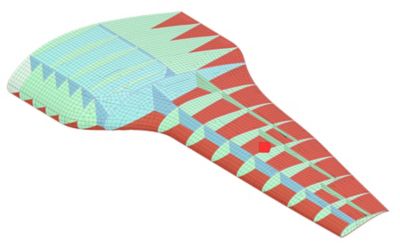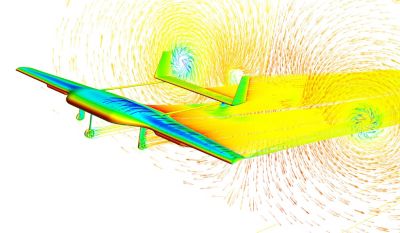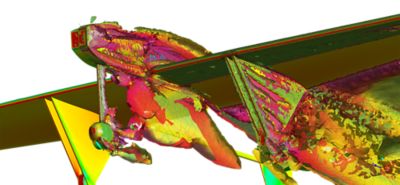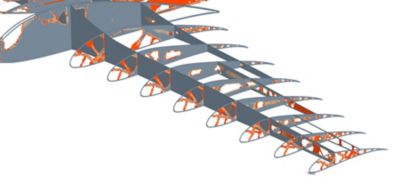-
-
학생용 무료 소프트웨어에 액세스하기
차세대 엔지니어에게 힘을 실어주는 Ansys
학생들은 세계적 수준의 시뮬레이션 소프트웨어를 무료로 이용할 수 있습니다.
-
지금 바로 Ansys에 연결하십시오!
미래를 설계하기
시뮬레이션이 다음 혁신을 어떻게 지원할 수 있는지 알아보려면 Ansys와 연결하십시오.
국가
무료 트라이얼
제품 및 서비스
학습하기
회사 정보
Back
제품 및 서비스
ANSYS BLOG
August 11, 2022
UNAM Students’ Dreams Take Flight with Simulation
Most kids love things that fly, especially airplanes — whether it takes a simple flick of the wrist, a rubber band winding, or a battery-powered remote control to send them airborne. This fascination can lead to science, technology, engineering, and math (STEM) learning opportunities beyond grade school. For Miguel Cobian, a student responsible for leading the mechanical design system efforts of the aero design student team at the Universidad Nacional Autónoma de México (UNAM), the opportunity to join a student engineering team to design aircraft was really a childhood dream come true.
“I’ve always been fascinated with planes,” says Cobian. “As a kid, I would try to imagine how such heavy things like airplanes could ever leave the ground. At the university level, the technical and scientific aspects took hold, to the point at which all I wanted to do as an engineering student was to keep learning and understanding these phenomena to design very big, heavy things that can actually fly.”
Cobian manages the students and the schedule, plotting out the team’s trajectory — e.g., who will do what job where and how many events the team will take on during the year. All of the team’s hard work is focused on winning Society of Automotive Engineers (SAE) aero design student engineering competitions.

Structure for fluid-solid interaction (FSI) analysis of a blended wing designed by the team.
His partner, Chief Technology Officer Michel Gordillo, is responsible for managing all of the technological resources of the team, including the free simulation software they receive through the Ansys Academic Student Team Partner Program. Gordillo must ensure that their aircraft is competitive, legal, and meets current regulations. He leads the team through the technical challenges of the competition and makes major design decisions. Both Gordillo and Cobian are at the top of their class and are on a great academic trajectory, but they recognized that knowledge based strictly on passing exams was not going to fly in the real world.
“I wanted to be confident of my knowledge,” says Gordillo. “I wanted a steeper learning curve, and I think you can only experience it by imposing new challenges on yourself, which is why I joined the team. I also like the aerospace sector and thought our team was the best place to learn and pick up valuable experience along the way.”

Fluent analysis of Mobula.
Simulation Helps Future Engineers Spread their Wings
The Ansys Academic Program supports student teams like the UNAM Aero Design team with the simulation software, training resources, and access to learning opportunities that make participation in these competitions possible through Student Team Partnerships. Participation enables the team to take the aerodynamic fundamentals and theoretical equations they’ve learned in class and apply them in the real world using simulation to design unmanned aircraft.
With help from Ansys, student teams can learn the ins and outs of simulation software and sharpen their skills through online tutorials or university courses as they go, as well as interact with other Ansys users in the Learning Forum. It’s a win-win for students, who will graduate with industry-ready skills that will help them to prepare for and secure jobs after graduation. Ansys’ continuous collaboration with the team began about four years ago. The UNAM Aero Design team is one of more than 500 Ansys sponsored teams that have access to free software, resources, and support through partnership with Ansys.
“It’s a real-world application,” says Vishal Ganore, Academic Project Manager at Ansys. “In designing a mini-sized aircraft, students are gaining hands-on experience and insight into how they can design a bigger aircraft. If they encounter a company in the aerospace domain, they have the expertise needed to demonstrate their knowledge of small aircraft design using simulation and land a job right out of college. And we know these students are some of the most sought-after by employers.”

Mobula aircraft designed by the UNAM Aero Design team, winner of second place overall, SAE Aero Design East: Advanced Class 2021.
Team UNAM Soars Through Competition
The Society of Automotive Engineers (SAE) connects and educates engineers while promoting, developing, and advancing aerospace, commercial vehicle, and automotive engineering. One of the ways SAE achieves its objectives is through student competitions. During these events, student teams from multiple universities, including UNAM, are challenged to build remote-controlled, mini-sized flying aircraft in multiple categories: regular class, advanced class, and micro class.
At 54 members strong, UNAM’s Aero Design team is among the largest teams at the university and the only aero design team to date. They mainly compete in the advanced class, where they are tasked with delivering an aircraft capable of carrying and releasing various payloads. It also requires the related telemetry to monitor flight information around very complex missions.
Team UNAM manufactures a prototype of a mini aircraft using Ansys tools to look at aircraft efficiency and the external aerodynamics of the aircraft. They also perform structural analysis of the aircraft wings to make sure the structure is stable, which provides an excellent opportunity for students on the team who are interested in the aerospace industry. Participation involves realworld project experience connected to aerospace, plus the chance to apply important engineering knowledge and the fundamentals they receive in class to explore industrial software, including flagship products like Ansys Fluent, Ansys CFX, and Ansys Mechanical.
“Our team used a lot of Ansys products and was able to learn them all without any previous experience,” says Cobian. “The interface is very pretty and easy to understand. So, if you understand, for example, that you have to go from left to right preparing your analysis using this specific method in Fluent, you can apply this user experience to Mechanical. Once you get the basics of one Ansys simulation tool, it’s easy to extrapolate this knowledge and apply it to other Ansys simulation tools.”

Turbulent study around sharp edges from fuselage and landing gear elements.
With Ansys, the Sky's the Limit
In any given year, participation in multiple competitions is not unusual — including this year with advanced competitions in the United States and a regular competition in Mexico. To meet different timing and requirements, two or three unique aircraft designs are required, as well as extreme coordination among team members to get them done. Moving in and out of design phases, the team often runs tasks in parallel, or sequentially when they can’t, using Ansys products to optimize their workflow structure and meet competing deadlines. This level of coordination was particularly important during the pandemic.
“What might be different from past student teams is the level of ingenuity that went into the past two years — keeping the team together, sometimes in isolation, sometimes on campus,” says Gordillo. “We had to work as a team, and Ansys gave us the flexibility to collaborate remotely or participate on campus as needed to successfully achieve our goals.”

Topological optimization of aircraft structures performed in Ansys Mechanical.

Modal analysis of aircraft structure.
To access simulation software off campus and facilitate information sharing, Gordillo set up a server at home using remote desktop software to extend the resource pool beyond individual laptops. This enabled team members to communicate directly with the server to activate licenses and run simulations off campus from wherever they were. The setup also enabled team members to obtain values for different design conditions via simulation, then share the data coming out of those simulations among themselves to successfully work through their concepts.
“Everyone is very keen on giving their best and going all out on the work they are doing,” says Gordillo. “I think competing has been a huge learning experience, and I’m just grateful that I found in the team a community of super capable, intelligent people in which we are free to innovate, to bring ideas to the table, and not be afraid to test them.”
Just how has all this teamwork paid off? In 2021, the UNAM Aero Design team won second place overall internationally and second place in the technical presentation for the Advanced Class competition in the U.S. So far this year, the team also took first place twice in Mexico for their technical report and technical presentation and is looking forward to more wins in the future.
“So, as you can see, all these things we’re implementing, and all the support we are receiving from Ansys, is really helping us in competitions,” says Cobian. “We constantly keep growing and keep going forward as a team.”